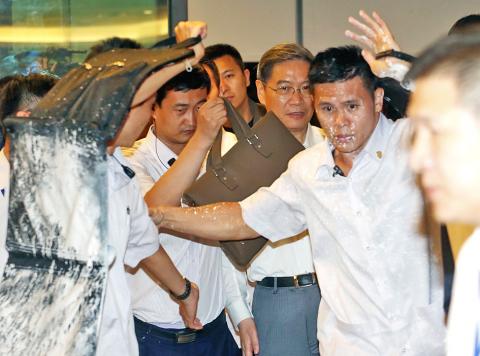A mess of white paint and joss paper greeted delegates to the second meeting between Mainland Affairs Council (MAC) Minister Wang Yu-chi (王郁琦) and China’s Taiwan Affairs Office Minister Zhang Zhijun (張志軍) in Greater Kaohsiung on Friday.
Protesters, including members of the Black Island National Youth Front and the Taiwan Solidarity Union, were already present and chanting slogans when Zhang’s vehicle arrived near the Sizihwan Sunset Beach Resort, the venue for the meeting.
“Taiwan’s future should be decided by Taiwanese,” “Zhijun came, and democracy died” and “We condemn police violence,” they shouted.

Photo: CNA
Protesters said the cavalcade resembled a funeral procession, as Zhang’s vehicle entered the resort slowly, flanked by security agents.
A student protester surprised the police by appearing suddenly and tossing ghost money at the convoy, but was soon taken away by police.
In the chaos, another protester splashed white paint at Zhang’s vehicle, hitting several security personnel, who were protecting the car.
The police opened up black umbrellas as protesters threw water at the car, making the scene further resemble a funeral.
Taiwan Solidarity Union (TSU) member Chen Chang-huei (陳昌輝) tried to force his way into the venue, but was blocked and removed by police, despite other TSU members wrestling with them.
In the commotion, Chen seemed to have tripped and hit his head on the ground. He lost consciousness and was taken to the hospital.
At least 400 policemen were dispatched to the site and an additional 66 special officers deployed.
The student who tossed the joss paper was injured by the police.
He said he did not belong to any group, and that he was merely an adult who cared about Taiwan’s future and wanted the public’s dissenting voices to be heard.
The group accused the police of turning into Chinese public security agents who protected a low-ranking Chinese official, but used violence against young Taiwanese.
After the Chinese guests finally got into the building, MAC Deputy Minister Chang Hsien-yao (張顯耀) appeared outside the venue visibly angered.
He criticized council staff and demanded to speak to the police officer in charge, questioning why there was an insufficient police force present.
Chang then started to direct the police, ordering a SWAT team to stand by the door.
Yesterday, Zhang said the protests were “normal.”
“Taiwan is a pluralistic society where people hold a diversity of views. It’s normal. I believed that both sides of the Strait should adhere to a path of peaceful development in cross-strait relations and this is also mainstream public opinion,” Zhang said.
However, Zhang did not comment on the paint-splashing incident on Friday night.
Wang told reporters late on Friday night that he had told Zhang people protesting to make their voices heard is “a part of life in Taiwan,” and that he must get accustomed to it because Taiwan is a democratic society.
“I told him that this is pretty much what we experience in our daily lives. We are used to it. Now that he is head of the Taiwan Affairs Office, he has to understand Taiwan more,” Wang said.
For her part, Greater Kaohsiung Mayor Chen Chu (陳菊) said yesterday that people expressing their views in a non-peaceful manner is not the sort of hospitality that Taiwanese should show.
Additional reporting by Peng Hsien-chun

US climber Alex Honnold is to attempt to scale Taipei 101 without a rope and harness in a live Netflix special on Jan. 24, the streaming platform announced on Wednesday. Accounting for the time difference, the two-hour broadcast of Honnold’s climb, called Skyscraper Live, is to air on Jan. 23 in the US, Netflix said in a statement. Honnold, 40, was the first person ever to free solo climb the 900m El Capitan rock formation in Yosemite National Park — a feat that was recorded and later made into the 2018 documentary film Free Solo. Netflix previewed Skyscraper Live in October, after videos

Starting on Jan. 1, YouBike riders must have insurance to use the service, and a six-month trial of NT$5 coupons under certain conditions would be implemented to balance bike shortages, a joint statement from transportation departments across Taipei, New Taipei City and Taoyuan announced yesterday. The rental bike system operator said that coupons would be offered to riders to rent bikes from full stations, for riders who take out an electric-assisted bike from a full station, and for riders who return a bike to an empty station. All riders with YouBike accounts are automatically eligible for the program, and each membership account

NUMBERS IMBALANCE: More than 4 million Taiwanese have visited China this year, while only about half a million Chinese have visited here Beijing has yet to respond to Taiwan’s requests for negotiation over matters related to the recovery of cross-strait tourism, the Tourism Administration said yesterday. Taiwan’s tourism authority issued the statement after Chinese-language daily the China Times reported yesterday that the government’s policy of banning group tours to China does not stop Taiwanese from visiting the country. As of October, more than 4.2 million had traveled to China this year, exceeding last year. Beijing estimated the number of Taiwanese tourists in China could reach 4.5 million this year. By contrast, only 500,000 Chinese tourists are expected in Taiwan, the report said. The report

Temperatures are forecast to drop steadily as a continental cold air mass moves across Taiwan, with some areas also likely to see heavy rainfall, the Central Weather Administration (CWA) said. From today through early tomorrow, a cold air mass would keep temperatures low across central and northern Taiwan, and the eastern half of Taiwan proper, with isolated brief showers forecast along Keelung’s north coast, Taipei and New Taipei City’s mountainous areas and eastern Taiwan, it said. Lows of 11°C to 15°C are forecast in central and northern Taiwan, Yilan County, and the outlying Kinmen and Lienchiang (Matsu) counties, and 14°C to 17°C